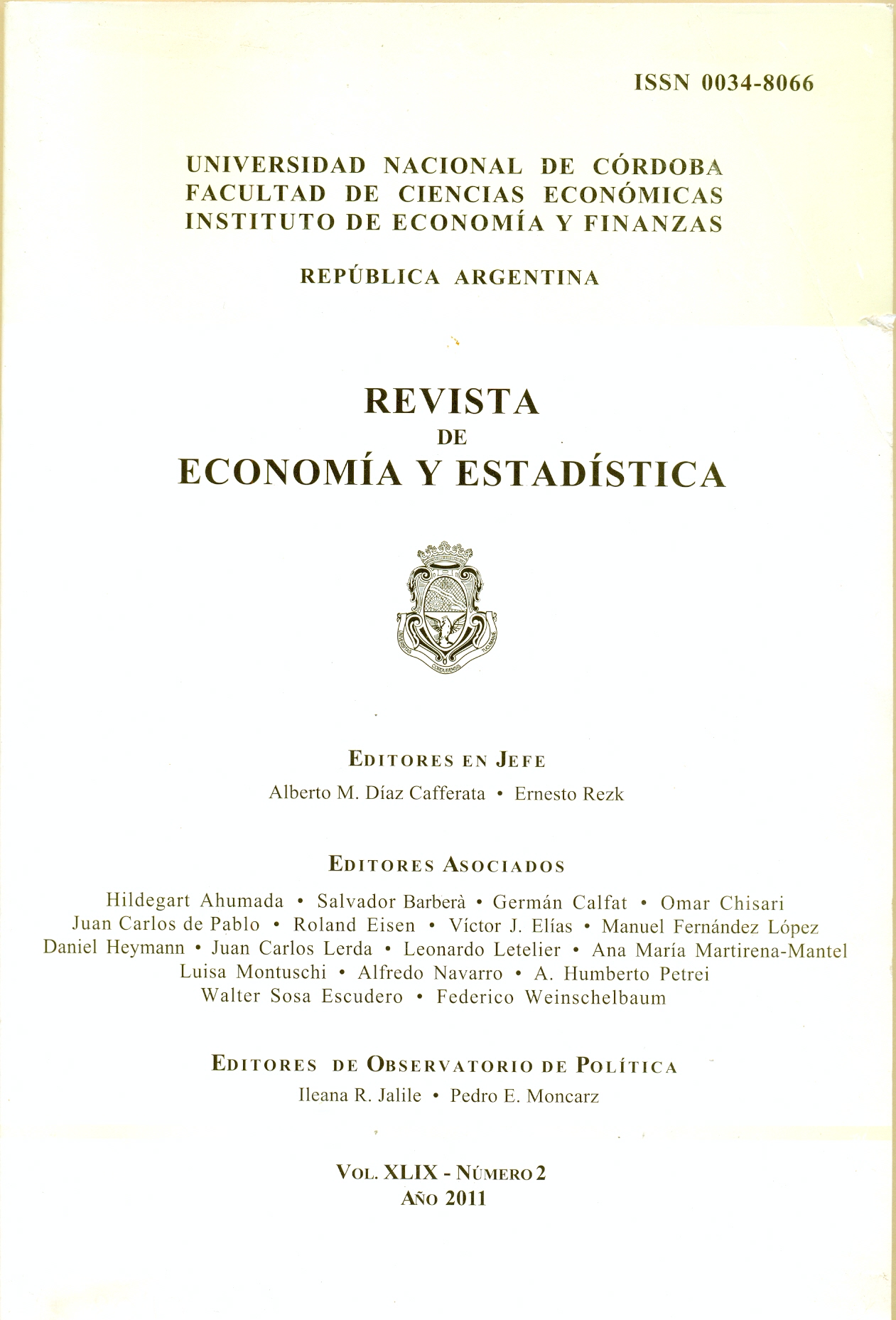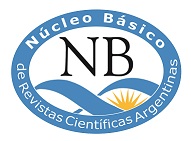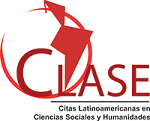Estimación de la valoración subjetiva de los ahorros de tiempo de viaje y espera en la Ciudad de Córdoba, Argentina
DOI:
https://doi.org/10.55444/2451.7321.2011.v49.n2.7491Palabras clave:
demanda de transporte, preferencias declaradas, logit multinomial, valor del tiempo.Resumen
El presente estudio utiliza una encuesta de preferencias declaradas para estimar un modelo de demanda logit multinomial de elección de modo de transporte para realizar viajes al trabajo. Los resultados han permitido estimar las valoraciones subjetivas de los ahorros de tiempo de viaje y tiempo de espera considerando viajes del hogar al trabajo en la Ciudad de Córdoba. Se ha comprobado que las mejoras de los tiempos de viaje y espera en los servicios de autobús urbano, que podrían efectivizarse a través de la implementación de carriles exclusivos para este modo de transporte, provocarían importantes incentivos al uso del autobús para viajar al trabajo y una disminución del uso de los modos de transporte privado (automóvil y motocicleta), lo que permitiría disminuir en algún grado la congestión vehicular existente en horas pico en la ciudad.
Descargas
Referencias
Bates, J. (1980). “Econometric Issues in stated preference analysis”. Journal of Transport Economics and Policy, January.
Bates, J. J. y Terzis G. (1997). “Stated Preference and the "Ecological Fallacy"”, PTRC European Transport Forum, Transportation Planning Methods, vol. II.
Ben-Akiva, M. y Lerman S. (1985). Discrete Choice Analysis: Theory and Application to Travel Demand. MIT Press.
Bierlaire, M. (2003). “BIOGEME: A free package for the estimation of discrete choice models”, Proceedings of the 3rd Swiss Transportation Research Conference, Ascona, Switzerland.
Bierlaire, M. (2009). “Estimation of discrete choice models with BIOGEME 1.8”. Disponible en http://transp-or2.epfl.ch/biogeme/doc/tutorial.pdf .
Bliemer, M. y Rose J. M. (2005). “Efficient designs for alternative specific choice experiments”. Working Paper ITLS-WP-05-04. Institute of Transport Studies. The University of Sydney.
Bradley, M. y Daly A. (1994). “Use of the logit scaling approach to test for rank-order and fatigue effects in stated preference data”. Transportation, vol. 21, n. 2, pp. 167-184.
Brownstone, D. y Train K. (1998). “Forecasting new product penetration with flexible substitution patterns”. Journal of Econometrics, vol. 89, n. 1-2, pp. 109-129.
ChoiceMetrics (2009). “ChoiceMetrics 2009, Ngene 1.0 User manual and reference guide. The cutting edge in experimental design”.
Dhar, R. (1997). “Consumer Preference for a No-Choice Option”. The Journal of Consumer Research, Vol. 24, n. 2, pp. 215-231.
Dhar, R. y Simonson I. (2003). “The Effect of Forced Choice on Choice”. Journal of Marketing Research, Vol. 40, n.2, pp. 146-160.
Dissanayake, D. y Morikawa T. (2010). “Investigating household vehicle ownership, mode choice and trip sharing decisions using a combined revealed preference/stated preference Nested Logit model: case study in Bangkok Metropolitan Region”. Journal of Transport Geography, Vol. 18, pp. 402-410.
Fowkes A. y Wardman M. (1998). “The design of stated preference travel choice experiments: with special reference to interpersonal taste variations”. Journal of Transport Economics and Policy, Vol. 22, n. 1.
Haaijer, M. (1999). Modeling conjoint choice experiments with the probit model. The Netherlands: Labyrint Publications.
Hensher D., Barnard P. y Truong T. (1988). “The role of stated preference methods in studies of travel choice”. Journal of Transport Economics and Policy, Vol. 22, n. 1.
Hensher, D. (1994). “Stated preference analysis of travel choices: the state of practice”. Transportation, Vol. 21: pp.107-133. Kluwer Academic Publishers, Netherlands.
Hensher, D. y Reyes A. (2000). “Trip chaining as a barrier to the propensity to use public transport”. Transportation, Vol. 27, pp. 341-361. Kluwer Academic Publishers, Netherlands.
Hensher, D. (2001). “The valuation of commuter travel time savings for car drivers: evaluating alternative model specifications”, Transportation, Vol. 28, pp. 101-118.
Hensher, D., Rose J. y Greene W. (2005). Applied Choice Analysis. A Primer. Cambridge University Press. Cambridge. UK.
Hojman, P., Ortúzar J. y Rizzi L. (2004). “Internet-Based Surveys to Elicit the Value of Risk Reductions”, Proccedings of the 7th International Conference on Travel Survey Methods, Los Sueños, Costa Rica.
Jara-Díaz, S. y Guevara C. (2003). “Behind the Subjective Value of Travel Time Savings. The perception of Work, Leisure, and Travel from a Joint Mode Choice Activity Model”, Journal of Transport Economics and Policy, Vol. 37, n. 1, 29-46.
Louviere, J., Hensher D. y Swait J. (2000). Stated Choice Methods. Analysis and Application. Ed. Cambridge University Press.
Mackie, P. (2005). “The London congestion charge: A tentative economic appraisal. A comment on the paper by Prud'homme and Bocarejo”. Transport Policy, Vol. 12, n. 3, pp. 288-290.
Marconetti, D. (2008). “Limpieza, tránsito y transporte con mala nota”. La Voz del Interior, 7 de diciembre.
McFadden, D. (1974). Conditional Logit Analysis of Qualitative Choice Behaviour, Frontiers of Econometrics, Zarembka, P. (ed.), Academic Press, New York, pp. 105-142.
Mohring, H. (1999). “Congestion”. En Essays in Transportation Economics and Policy. A Handbook in honor of John R. Meyer, Chapter 6. José Gómez-Ibáñez, William B. Tye y Clifford Winston, eds. The Brookings Institution.
Newbery, D. (2003). “Pricing and congestion: economic principles relevant to pricing roads”. En Cost-Benefit Analysis, Capítulo 13; Layard, R. y Glaister, S. eds., Cambridge University Press.
Prud’homme, R. y Bocarejo J. (2005). “The London congestion charge: a tentative economic appraisal”. Transport Policy, vol. 12, n. 3, pp. 279-287.
Rose, J. M., Scarpa R. y Bliemer M. (2009). “Incorporating model uncertainty into the generation of efficient stated choice experiments: A model averaging approach”, International Choice Modelling Conference, Yorkshire U.K.
Rose, J. M. y Bliemer M. (2004). “The design of stated choice experimentes: The State of Practice and Future Challenges”. Working Paper ITS-WP-04-09. Institute of Transport Studies. University of Sydney y Monash University.
Rose J. M. y Hensher D. (2004). “Handling individual specific availability of alternatives in stated choice experiments”. Seventh International Conference on Travel Survey Methods. Costa Rica.
Rose J. M. y Bliemer M. (2009). “Constructing Efficient Choice Experiments”. Working Paper ITLS-WP-05-07, 2005. Institute of Transport Studies. University of Sydney.
Train, K. (2009). Discrete Choice Methods with Simulation, Cambridge University Press.
Wardman, M. (2004). Public transport values of time. Transport Policy, vol. 11, n. 4, pp. 363-377.
Descargas
Publicado
Número
Sección
Licencia
Derechos de autor 2011 Juan José Pompilio Sartori, Jorge Mauricio Oviedo

Esta obra está bajo una licencia internacional Creative Commons Atribución-NoComercial-SinDerivadas 4.0.
Aquellos autores/as que tengan publicaciones con esta revista, aceptan los términos siguientes:
Los autores/as conservarán sus derechos de autor y garantizarán a la revista el derecho de primera publicación de su obra, el cuál estará simultáneamente sujeto a la Licencia Creative Commons Atribución-NoComercial-SinDerivar 4.0 Internacional que permite a terceros compartir la obra siempre que se indique su autor y su primera publicación esta revista.
Los autores/as podrán adoptar otros acuerdos de licencia no exclusiva de distribución de la versión de la obra publicada (p. ej.: depositarla en un archivo telemático institucional o publicarla en un volumen monográfico) siempre que se indique la publicación inicial en esta revista.
Se permite y recomienda a los autores/as difundir su obra a través de Internet (p. ej.: en archivos telemáticos institucionales o en su página web) antes y durante el proceso de envío, lo cual puede producir intercambios interesantes y aumentar las citas de la obra publicada. (Véase El efecto del acceso abierto)














